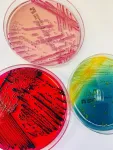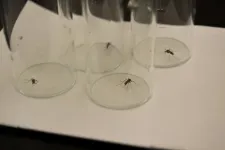(Press-News.org) Philadelphia, January 8, 2024 – Researchers from Children’s Hospital of Philadelphia (CHOP) have developed a new AI-powered algorithm to help understand how different cells organize themselves into particular tissues and communicate with one another. This new tool was tested on two types of cancer tissues to reveal how these “neighborhoods” of cells interact with one another to evade therapy, and more studies could reveal more information about the function of these cells in the tumor microenvironment.
The findings were published online today by the journal Nature Methods.
To understand how different cells organize themselves to support the functions of a tissue, researchers proposed the concept of tissue cellular neighborhoods (TCNs) to describe functional units in which different, recurrent cell types work together to support specific tissue functions. Across individuals, the functions of these TCNs would remain the same. However, translating the huge amount of information in spatial omics data into models and hypotheses that can be interpreted and tested by researchers requires advanced AI algorithms.
“It is very difficult to study the tissue microenvironment, how certain cells organize, behave and communicate with one another,” said senior study author Kai Tan, PhD, an investigator in the Center for Childhood Cancer Research at CHOP and a professor in the Department of Pediatrics and the Perelman School of Medicine at the University of Pennsylvania. “Until recent advances in so-called spatial omics technology, it was impossible to spatially characterize more than 100 proteins or hundreds or even thousands of genes across a piece of tissue, which might be home to hundreds of thousands of cells and their respective genes.”
In this study, researchers developed the deep-learning-based CytoCommunity algorithm to identify TCNs based on cell identities of a tissue sample, their spatial distributions as well as patient clinical data, which can help researchers better understand how these neighborhoods of cells are organized and are associated with certain clinical outcomes. In this study, tissue samples from breast and colorectal tumors were used because of a high volume of data available, enough to train the algorithm to identify TCNs associated with high-risk disease subtypes.
By using CytoCommunity for breast and colorectal cancer data, the algorithm revealed new fibroblast-enriched TCNs and granulocyte-enriched TCNs specific to high-risk breast cancer and colorectal cancer, respectively.
“Since we were able to prove the effectiveness of CytoCommunity, the next step is to apply this algorithm to both healthy and diseased tissue data generated by research consortia such as HuBMAP (Human BioMolecular Atlas Program) and HTAN (Human Tumor Atlas Network)” Tan said. “For instance, using data from childhood cancers such as leukemia, neuroblastoma and high-grade gliomas, we hope to find tissue cellular neighborhoods that might be associated with responses to certain therapies and combine our findings with genetic data to help determine which genetic pathways may be involved at the cellular and molecular levels.”
This study was supported by National Institutes of Health grant CA233285, HL165442 and HL156090, a grant from the Chan Zuckerberg Initiative (AWD-2021-237920), a grant from the Leona M. and Harry B Helmsley Charitable Trust (no. 2008-04062), a National Natural Science Foundation of China grant no. 62002277, a grant from the Young Talent Fund of University Association for Science and Technology in Shaanxi (no. 20210101), a grant from the Fundamental Research Funds for the Central Universities (no. QTZX23051), and National Natural Science Foundation of China grant nos. 62132015 and U22A2037.
Hu et al, “Unsupervised and supervised discovery of tissue cellular neighborhoods from cell phenotypes.” Nat Methods. Online January 8, 2024. DOI: 10.1038/s41592-023-02124-2.
About Children’s Hospital of Philadelphia:
A non-profit, charitable organization, Children’s Hospital of Philadelphia was founded in 1855 as the nation’s first pediatric hospital. Through its long-standing commitment to providing exceptional patient care, training new generations of pediatric healthcare professionals, and pioneering major research initiatives, the hospital has fostered many discoveries that have benefited children worldwide. Its pediatric research program is among the largest in the country. The institution has a well-established history of providing advanced pediatric care close to home through its CHOP Care Network, which includes more than 50 primary care practices, specialty care and surgical centers, urgent care centers, and community hospital alliances throughout Pennsylvania and New Jersey, as well as the Middleman Family Pavilion and its dedicated pediatric emergency department in King of Prussia. In addition, its unique family-centered care and public service programs have brought Children’s Hospital of Philadelphia recognition as a leading advocate for children and adolescents. For more information, visit https://www.chop.edu.
END
CHOP researchers develop algorithm to determine how cellular “neighborhoods” function in tissues
Data from this method could be used to discover how cancers are able to evade therapy and provide better insight into underlying tumor mechanisms
2024-01-08
ELSE PRESS RELEASES FROM THIS DATE:
Researchers engineer in vivo delivery system for prime editing, partially restoring vision in mice
2024-01-08
Prime editing, a versatile form of gene editing that can correct most known disease-causing genetic mutations, now has a new vehicle to deliver its machinery into cells in living animals.
A team of researchers at the Broad Institute of MIT and Harvard has engineered virus-like particles to deliver prime editors to cells in mice at a high enough efficiency to rescue a genetic disorder. In the new work published today in Nature Biotechnology, the team adapted engineered virus-like particles (eVLPs) that they had previously designed to carry base editors — ...
Three iron rings in a planet-forming disk
2024-01-08
The origin of Earth and the Solar System inspires scientists and the public alike. By studying the present state of our home planet and other objects in the Solar System, researchers have developed a detailed picture of the conditions when they evolved from a disk made of dust and gas surrounding the infant sun some 4.5 billion years ago.
Three rings hinting at two planets
With the breathtaking progress made in star and planet formation research aiming at far-away celestial objects, we can now investigate the conditions in environments around young stars and compare them to the ones derived for the early Solar System. Using the European Southern Observatory’s (ESO) Very Large ...
More than thirty new species of bacteria discovered in patient samples
2024-01-08
Unknown germs are a common occurrence in hospitals. Researchers at the University of Basel have spent many years collecting and analyzing them. They have identified many new species of bacteria, some of which are significant for clinical practice.
Bacterial infections can be treated more efficiently if the cause of the disease is known. In most cases, all it takes to identify a pathogen is an analysis in a medical laboratory. Sometimes, however, the standard methods are insufficient – for example, if the species of bacteria has not yet been classified or ...
Where do patients choose to undergo breast cancer surgery, and do these choices drive health care inequality?
2024-01-08
Including patients as partners for making decisions about their medical treatments is an important aspect of patient-centered care. A new study from England examined choices that patients with breast cancer make when considering where to have surgery for their condition and assessed how policies that offer such choices might affect inequalities in the health care system. The findings are published by Wiley online in CANCER, a peer-reviewed journal of the American Cancer Society.
For the study, investigators analyzed data from the National Health Service (NHS), the publicly ...
Some mosquitoes like it hot
2024-01-08
Certain populations of mosquitoes are more heat tolerant and better equipped to survive heat waves than others, according to new research from Washington University in St. Louis.
This is bad news in a world where vector-borne diseases are an increasingly global health concern. Most models that scientists use to estimate vector-borne disease risk currently assume that mosquito heat tolerances do not vary. As a result, these models may underestimate mosquitoes’ ability to spread diseases in a warming world.
Researchers led by Katie M. Westby, a senior scientist at Tyson Research Center, Washington ...
Out-of-pocket cost increase could put HIV prevention medications out of reach
2024-01-08
PHILADELPHIA – Increasing patients’ out of pocket costs for HIV pre-exposure prophylaxis (PrEP), medications, which have been shown to dramatically reduce the risk of HIV infection, could lead to a significant reduction in PrEP use and a rise in HIV infection rates, according to a new study co-led by researchers at the Perelman School of Medicine at the University of Pennsylvania and Johns Hopkins Bloomberg School of Public Health.
The study, published today in Health Affairs, was designed, in part, to explore the impact that out-of-pocket cost increases could have, depending on the outcome of an ongoing court case challenging certain ...
Survey finds majority of Americans think bariatric surgery is a shortcut to losing pounds, should only be a last resort
2024-01-08
Orlando, Fla - More than two in five U.S. adults suffer from obesity, an epidemic that continues to trend upward. While bariatric surgery is an extremely effective treatment option, a new national survey by Orlando Health reveals common stigmas that may deter those who qualify for surgery from pursuing the treatment they need.
“Treatment plans for obesity are tailored to each individual patient based on things like body mass index and existing medical conditions and may include medication, lifestyle changes, counseling and bariatric surgery,” said Andre Teixeira, MD, medical ...
First ever scientific study on First World War crater reveals new details on its history
2024-01-08
The spectacular explosion of the mine at Hawthorn Ridge – a fortified German front-line position in the First World War – marked the beginning of the Battle of the Somme, and remains one of the best-known pieces of film from the whole conflict.
More than 60ft below the surface, British miners had dug a gallery for more than 900 metres from their lines and packed it with 40,000 lbs of explosives. It was one of 19 mines placed beneath German front positions that were detonated on 1st July, 1916 to mark the start of the offensive.
But the detonation of the ...
Blood flow changes in the eyes could influence visual symptoms of migraines
2024-01-06
A recent study found changes in blood flow in the retina could explain why some migraine patients experience visual symptoms. The findings could represent a long-sought observable marker for migraines that doctors can use to aid in the clinical treatment of the condition.
While patients with migraines often experience symptoms such as pain around the eye, sensitivity to light, blind spots and visual blurring, the mechanisms behind those symptoms have not been well understood. UCLA Health researchers used a non-invasive imaging technique, known as optical coherence tomography angiography, or OCTA, ...
Global scientific network highlights plant genera named for women
2024-01-06
A network of scientists across the globe have identified more than 700 plant genera named for women. This is a nearly twenty-fold increase in the number of genera linked to women before the group started working on the list.
The project, which aimed to highlight the contribution of women to botany, was the result of social media conversations about plants named for people.
What began as a simple question about how many and which plant genera were named for women evolved into a global network of scientists who built ...
LAST 30 PRESS RELEASES:
Scientists trace microplastics in fertilizer from fields to the beach
The Lancet Obstetrics, Gynecology, & Women’s Health: Taking paracetamol during pregnancy does not increase risk of autism, ADHD or intellectual disabilities, confirms new gold-standard evidence review
Taking paracetamol during pregnancy does not increase risk of autism, ADHD or intellectual disabilities
Harm reduction vending machines in New York State expand access to overdose treatment and drug test strips, UB studies confirm
University of Phoenix releases white paper on Credit for Prior Learning as a catalyst for internal mobility and retention
Canada losing track of salmon health as climate and industrial threats mount
Molecular sieve-confined Pt-FeOx catalysts achieve highly efficient reversible hydrogen cycle of methylcyclohexane-toluene
Investment in farm productivity tools key to reducing greenhouse gas
New review highlights electrochemical pathways to recover uranium from wastewater and seawater
Hidden pollutants in shale gas development raise environmental concerns, new review finds
Discarded cigarette butts transformed into high performance energy storage materials
Researchers highlight role of alternative RNA splicing in schizophrenia
NTU Singapore scientists find new way to disarm antibiotic-resistant bacteria and restore healing in chronic wounds
Research suggests nationwide racial bias in media reporting on gun violence
Revealing the cell’s nanocourier at work
Health impacts of nursing home staffing
Public views about opioid overdose and people with opioid use disorder
Age-related changes in sperm DNA may play a role in autism risk
Ambitious model fails to explain near-death experiences, experts say
Multifaceted effects of inward foreign direct investment on new venture creation
Exploring mutations that spontaneously switch on a key brain cell receptor
Two-step genome editing enables the creation of full-length humanized mouse models
Pusan National University researchers develop light-activated tissue adhesive patch for rapid, watertight neurosurgical sealing
Study finds so-called super agers tend to have at least two key genetic advantages
Brain stimulation device cleared for ADHD in the US is overall safe but ineffective
Scientists discover natural ‘brake’ that could stop harmful inflammation
Tougher solid electrolyte advances long-sought lithium metal batteries
Experts provide policy roadmap to reduce dementia risk
New 3D imaging system could address limitations of MRI, CT and ultrasound
First-in-human drug trial lowers high blood fats
[Press-News.org] CHOP researchers develop algorithm to determine how cellular “neighborhoods” function in tissuesData from this method could be used to discover how cancers are able to evade therapy and provide better insight into underlying tumor mechanisms




